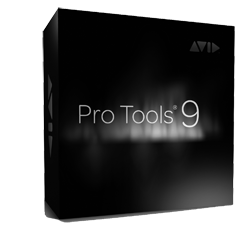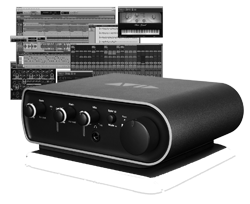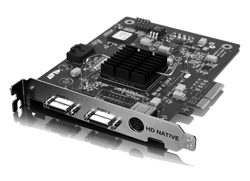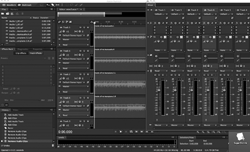by Steve Cunningham
The DAW wars continue apace. Let’s face it; folks in the production community have had an almost embarrassing wealth of choices when it comes to software multitrack recorders and editors, all battling one another for market share. Back in the day there were substantial differences between Pro Tools, Audition, and Vegas. But every year or so there’s a new version that tempts current users to switch. At this point most of these programs have copied one another’s features, so they all work pretty danged well. But every once in awhile, one of them does something really different, something that creates a buzz on the floor of a convention. This month is all about that.
As it happens, I’ve recently returned from a weekend in San Francisco for the AES Convention. While I was there I underwent my yearly re-grooving (guess I’m still not groovy enough) at Pro Tools Central in Daly City. It was there that I was truly surprised by what the folks at the Company Formerly Known as Digidesign, now Avid (see sidebar), hath wrought. What I saw was a true November surprise indeed. That surprise was Pro Tools version 9.
KIND OF A REALLY HUGE DEAL
 Now, before you go on a verbal tear -- “What’s with this guy? Another Pro Tools review? Didn’t I just read one of these about a year ago? Besides, I don’t even like Pro Tools because (fill in the blank)!” -- realize that it has been a bit longer than that. It was almost two years ago that we looked at Pro Tools 8. But this is not really a review of the recently-released Pro Tools 9, since the basic functionality of the software is not much changed. What has changed, and in a very big way, is the environment in which the software runs, which may well mollify quite a few non-users. The long and short of it is that with version 9 Avid has completely decoupled the Pro Tools software from the hardware.
Now, before you go on a verbal tear -- “What’s with this guy? Another Pro Tools review? Didn’t I just read one of these about a year ago? Besides, I don’t even like Pro Tools because (fill in the blank)!” -- realize that it has been a bit longer than that. It was almost two years ago that we looked at Pro Tools 8. But this is not really a review of the recently-released Pro Tools 9, since the basic functionality of the software is not much changed. What has changed, and in a very big way, is the environment in which the software runs, which may well mollify quite a few non-users. The long and short of it is that with version 9 Avid has completely decoupled the Pro Tools software from the hardware.
Allow me to repeat: You can run Pro Tools 9 software on any current Avid interface (including a Digidesign-labeled Mbox 2-series), or on any ASIO or Core Audio interface your little heart desires (Avid are working on a list of “approved” interfaces, which you can read as “tested”). You can even run it on no hardware whatsoever, relying on your computer’s built-in audio gozintas and gozoutas, so long as the sound card supports ASIO or Core Audio, and so long as your computer is on the “approved” list, as has always been the case. In any event, Avid has effectively vaporized one of the biggest objections to Pro Tools.
Pro Tools 9 represents a re-structuring of the company’s existing software categories, and goes along with their newly-released interfaces (all of which carry the Avid logo, of course, more below). The LE-series is gone altogether, replaced with the generic Pro Tools 9 software which carries some substantial increases in capacity compared to 8. The former m-Audio version, Pro Tools m-Powered, “will continue to be developed,” according to the company, but they have little else to say about it.
Pro Tools 9’s capacities include track counts that are double what was in the LE 8 version. In LE 8 you can have 48 mono or stereo tracks in a session; in PT 9 you can have 96 mono or stereo tracks. LE 8 has up to 128 aux tracks, PT 9 has 160, while internal busses jump from 32 to a whopping 256. Other types of tracks are also doubled -- up to 32 simultaneous record tracks, 64 instrument tracks, and 512 MIDI tracks. Granted, most of us won’t use any of the latter, but what the hey, there they are.
GOOD STUFF FOR FREE
More important to me is the addition to PT 9 of ADC, or Automatic Delay Compensation. Previously, only the expensive HD systems gave you ADC, but now it’s available in the cheap stuff, and for free. Why do you care? If you use a lot of effects on a track, you may notice that those effects produce a slight delay on playback when compared to the other tracks. This is because it takes time to calculate the effect and apply it to the audio in real time. The delay can be short and inaudible, as little as a few hundred samples worth. But some effects create longer delays... a single Lexicon reverb plug will generate a couple thousand samples of delay. For a mono voice track it’s no big deal, but if your track is stereo then the delay will definitely mess with the phase and create artifacts. ADC solves this problem by noting the amount of delay produced by all the effects on a track, then delaying all the other tracks by that amount so they all play together in perfect sync. The best part is that this is all automatic -- you don’t need to give it so much as a thought.
Here’s a Pro Tools “option” that always annoyed me to no end: Previously you had to pay an extra twenty bucks for the MP3 Option, which allows you to export or bounce your audio directly to disk in the mp3 format, instead of having to convert it later in iTunes or WinAmp or some such. The MP3 Option is now included free in PT 9. So is the Time Code ruler, which allows me to take the occasional video sweetening job. In earlier versions I’d need to buy DV Toolkit for several hundred bucks to get it, but not anymore.
 For those who don’t already have an Mbox 2-series interface, I definitely recommend that you take a look at the new Mbox series (called Mbox 3 by the Avid rep at the show, but the website has labels with no numbers). They’re encased in extruded aluminum instead of plastic, so even the Mini is heavier with a more substantial feel to it than the previous version, and the buttons and knobs don’t feel as delicate. But the big deal with these is the electronics -- the new Mboxes sound noticeably better than the 2-series units they replace. Even in the less-than-ideal conditions of a convention, the improvement was palpable, with more open highs and better stereo imaging.
For those who don’t already have an Mbox 2-series interface, I definitely recommend that you take a look at the new Mbox series (called Mbox 3 by the Avid rep at the show, but the website has labels with no numbers). They’re encased in extruded aluminum instead of plastic, so even the Mini is heavier with a more substantial feel to it than the previous version, and the buttons and knobs don’t feel as delicate. But the big deal with these is the electronics -- the new Mboxes sound noticeably better than the 2-series units they replace. Even in the less-than-ideal conditions of a convention, the improvement was palpable, with more open highs and better stereo imaging.
HD NATIVES
There are changes in PT 9 HD as well, mostly in terms of capacities. The maximum track count is still 192 across the board, with the other counts the same or slightly greater than is the non-HD version. However, Avid used the occasion of the software rollout to further reinforce the concept of HD Native, which uses a new, cheaper card installed in your computer. This card has no DSP processing on it as does the standard Core card, and instead relies on your computer’s CPU to do all the work. This is the same as what happens with a standard PT 9 system, or an LE 8 system.
 But rather than buying an $8k Core card plus a $4k interface to get a rig that will stand up in a commercial facility, you can now buy an HD Native card for about $3.5k and connect a high-end interface to that. Several months ago Avid introduced a mid-priced HD interface, specifically to go along with the HD Native card. The HD Omni interface comes with four analog inputs and eight analog outputs, plus eight-in, eight-out digital connections, all retailing for $3k. It will do 24-bit recording at sample rates up to 192k, so it is probably even good enough for Dave Foxx!
But rather than buying an $8k Core card plus a $4k interface to get a rig that will stand up in a commercial facility, you can now buy an HD Native card for about $3.5k and connect a high-end interface to that. Several months ago Avid introduced a mid-priced HD interface, specifically to go along with the HD Native card. The HD Omni interface comes with four analog inputs and eight analog outputs, plus eight-in, eight-out digital connections, all retailing for $3k. It will do 24-bit recording at sample rates up to 192k, so it is probably even good enough for Dave Foxx!
There are still some features that one only gets using a Pro Tools HD system, although most of these will be of limited interest to production pros. VCA mixing is Big Fun, but I cannot imagine having so many channels to mix that I have a need to group faders under a VCA fader. Nor can I imagine the use in radio production for Solo AFL/PFL, or being able to control external decks, but there it is. The point, I think, is that the price of getting into a big-studio-quality Pro Tools system went down from $12k to $6.5k, and that’s retail. If you need to live large, this may certainly be an affordable way to do it, particularly when you combine these with an 8- or 12-core CPU tower.
REQUIREMENTS AND ILOK
The only downside to the decoupled PT 9 software that I can see is that it now requires an iLok USB dongle, which is different than for LE 8. Much as I don’t like them, I have become used to losing another USB port to a dongle. So be it. Other system requirements include Windows 7 Home Premium, Professional, or Ultimate in either 32- or 64-bit mode. Two gigs of RAM are required, with four gigs recommended. It’s much the same on the Mac side, with the minimum OSX version at 10.6.2 or greater, running in either 32- or 64-bit mode. Pro Tools 9 itself is still a 32-bit program... guess they didn’t quite have time to upgrade it to 64-bits but in reality that matters little here. Memory requirements are the same as for Windows.
As you might expect, the price for Pro Tools 9 software alone has taken a jump, in this case to $599. The HD version is $699, a hundred more as you might expect. While these numbers are a bit high, I expect they’ll be discounted at retail and besides, there’s a whole lot of useful stuff in there that used to be paid options, so overall it’s a good deal. For existing users, upgrades are $249 for non-HD, and $349 for HD.
Overall, Pro Tools is still nowhere near the cheapest show in town; for that, see last month’s issue for a review of Cocko’s Reaper. But Pro Tools is still the market leader, and the one editor that allows you to take your session to nearly any studio in the world. I got some hands-on time during the training, and it seemed stable and didn’t crash. So despite my instinctual misgivings about getting into a new version of software at Rev One, there’s enough here that I’m going to take a run at it anyway. My order’s in (but they’re backordered on iLoks until December 1, dammit) and I’m waiting.
ADOBE’S SURPRISE
 The second surprise of the month, although this one we’ve seen approaching for several months, comes from Adobe. A public beta version of Audition for the Macintosh was released on November 8th, which as I write this was just a couple of days ago. What I can tell you is that it looks good, and is a reasonable representation of what Audition 4 for the PC will look like.
The second surprise of the month, although this one we’ve seen approaching for several months, comes from Adobe. A public beta version of Audition for the Macintosh was released on November 8th, which as I write this was just a couple of days ago. What I can tell you is that it looks good, and is a reasonable representation of what Audition 4 for the PC will look like.
While there is no word on Audition 4 for the PC, I have it on reasonably good authority that this has been in beta test since early fall. No word yet on a release date, but a representative on Adobe’s own user forum says that the PC and Mac versions will have the same feature set. Since there are still quite a few features missing from the beta Mac version it is difficult to compare the two. But you can check it out for yourself at http://labs.adobe.com/technologies/audition/.
If you have a Mac, then you need to get a copy. If you don’t then find someone who does, because the PC version will likely be quite similar. Git ‘er done.
SIDEBAR: Avid/Digidesign
It is interesting to note that the Avid/Digidesign announcements come at the end of a rather tumultuous period for the company, never mind the crappy economy. For the past 15 years Avid had been a very hands-off parent to the young Turks at Digidesign, who continued after the acquisition to operate mostly as an autonomous unit. So did m-Audio, acquired by Avid in 2004, as they retained their brand name and operated as a unit of Digidesign. But at the beginning of 2010, all of that changed.
The company formerly known as Digidesign became just another arm of Avid, a company who has struggled for years to keep some share of the video production market away from Apple’s Final Cut Pro. Avid retired the name and logo, replacing the Digi mark on all products and marketing materials with the Avid mark. At the same time, several rounds of layoffs put a number of Digi employees on the street. These looked to me like dark days for Pro Tools users; Avid’s marketing folks promised that great things were coming, and that Pro Tools would get better as a result of all the restructuring. But I knew the two founders back in the Digidrum days, long before Pro Tools, and Digi somehow felt like family to me. Now it suddenly appeared to me that Avid had become the Borg, and Digidesign had been assimilated. So I watched and waited, hoping that the parent company wasn’t killing the goose that laid the golden egg, starving it for development resources that could potentially cripple the product line.
Boy, was I wrong. Please note that I am not privy to any “inside information” whatsoever, but it does appear to me that Avid finally bit the bullet and took some of the actions the marketplace has demanded. By decoupling the Pro Tools hardware from the software, Avid has granted users a wish that I’ve heard voiced in training sessions for the last ten years. They’ve also unlocked a raft of features that take good advantage of today’s powerful PCs and Macs, and which used to require the purchase of some extra “Toolkit.” Count me pleasantly surprised, at least so far, and I’m sure more will be revealed.
♦

